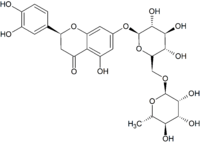Eriocitrin
 | |
| Names | |
|---|---|
| Other names
Eriodictyol-7-O-rutinoside | |
| Identifiers | |
| 13463-28-0 | |
| 3D model (Jmol) | Interactive image |
| ChemSpider | 75327 |
| ECHA InfoCard | 100.033.321 |
| PubChem | 83489 |
| |
| |
| Properties | |
| C27H32O15 | |
| Molar mass | 596.54 g·mol−1 |
| Except where otherwise noted, data are given for materials in their standard state (at 25 °C [77 °F], 100 kPa). | |
| Infobox references | |
Eriocitrin also known as eriodictyol glycoside is a flavanone-7-O-glycoside between the flavanone eriodictyol and the disaccharide rutinose. It is commonly found in lemons.[1] It is colloquially called lemon flavonoid or a citrus flavonoid, one of the plant pigments that bring color to fruit and flowers. It is a dietary supplement with lipid-lowering effects in animal models but its value in human nutrition has not been established. It is marketed as a dietary supplement usually in conjunction with B and C vitamins and other substances for relief of various ailments, but there is no established medical use or FDA approved application of the compound.
See also
References
- ↑ Miyake, Yoshiaki; Yamamoto, Kanefumi; Osawa, Toshihiko (1997). "Isolation of Eriocitrin (Eriodictyol 7-rutinoside) from Lemon Fruit (Citrus limon Burm. f.) and Its Antioxidative Activity". Food Science and Technology International, Tokyo. 3 (1): 84–89. doi:10.3136/fsti9596t9798.3.84. ISSN 1881-3976.
- Gel-Moreto, Nuria; Streich, René; Galensa, Rudolf (2003). "Chiral separation of diastereomeric flavanone-7-O-glycosides in citrus by capillary electrophoresis". Electrophoresis. 24 (15): 2716–2722. doi:10.1002/elps.200305486. ISSN 0173-0835.
This article is issued from Wikipedia - version of the 8/17/2016. The text is available under the Creative Commons Attribution/Share Alike but additional terms may apply for the media files.